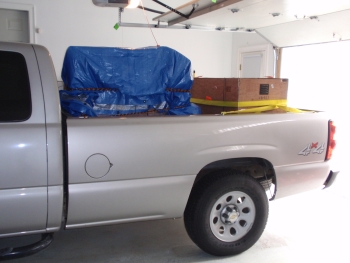 There are lots of companies that will finesse a set of reloading dies to a customer’s specification. There are any number of talented gunsmiths who would convert a $25 single shot Stevens heirloom shotgun into a double barrel express rifle. Unfortunately, this usually involves long lead time and a lot of cubic cash. Perhaps, more importantly, the finished work will never be the product of your craft skills, imagination or innovation. When you show off that fancy custom rifle done by Ben and Jerry’s Gunsmithing, you can express pride of ownership, but not pride of accomplishment.
There are lots of companies that will finesse a set of reloading dies to a customer’s specification. There are any number of talented gunsmiths who would convert a $25 single shot Stevens heirloom shotgun into a double barrel express rifle. Unfortunately, this usually involves long lead time and a lot of cubic cash. Perhaps, more importantly, the finished work will never be the product of your craft skills, imagination or innovation. When you show off that fancy custom rifle done by Ben and Jerry’s Gunsmithing, you can express pride of ownership, but not pride of accomplishment.
I am not an expert machinist. Boy, there’s an understatement. I know where to find the power switch on most equipment and how not to get my shirt caught in a spinning chuck…most of the time, but in a world of 0.0001″ precision? When I can make parts with within fractional inch tolerances I’m a pretty happy guy. I can make custom parts and tools for handloading. I can make parts for firearms where replacement parts may no longer exist. I can design improved pieces and, if I exercise care and make a commitment to learning before cutting, the Brownells catalogue becomes a perpetual source of enjoyment and I am able to move beyond the “drop in parts” notations. Everything becomes a potential to enhance firearm appearance and function.
Sometimes it is better to buy a machine rather than to build one…
The last micro lathe and milling machine set I purchased was really disappointing. I do not believe they were less than advertised. There is a culture built around buying low end imported Chinese micro lathes and milling machines that are sold with the understanding they will need to be rebuilt and refined before they can become useful. I spent a great deal of time learning how to take the equipment we had purchased apart to fix or adjust whatever was required. In only moderate use of the finished equipment, boards blew out, motors burned out, gears shed their teeth and their light weight and mostly alloy frames qualified them as limited in capacity and imprecise in output. When I moved the shop from California to Maine I gave them to a consummate machinist who liked to work with these small machines and had the time to dedicate to improvement of their basic machine functions and thought I would revisit the entire issue at a later date.
I took the experience I had gained with these small machines and spent a couple of weeks sifting through message board comments, web site pricing, equipment specs and service related comments. Much of what was out there was reflective of my early experience. People seemed very receptive toward receiving damaged and substandard goods from suppliers and taking on responsibility for its repair. More recently, a newly developed twist was the preponderance of companies that were selling air. They had no inventory, they were relatively evasive in providing customers with stock and backorder status, when what they were actually doing was collecting orders and/or funds in advance of placing orders with their suppliers. There is no savings to be had in this arrangement and all the customer is doing is providing time, effort and and financing for a company that demonstrates little respect respect for their business.
Grizzly Industrial, Inc. as an example, does not post stock status on their web site, even though it would be a simple task to do so, and they make getting stock status on even expensive machinery arduous to obtain over the phone prior to placing an order. When I placed an order for some relatively standard machine tools and accessories, they shipped what was in stock, and backordered several items that were critical for my purposes. I was advised via email that the items would ship approximately a month from the order date when the material was scheduled to arrive at their facility. From then on the only tracking device I had was that initial email. The items did not appears as open order status in the “My Account” area of the Grizzly site, nor was I advised of a change in the availability date when it was pushed out another month. Basically, they cherry picked my order then lost interest when the balance of the items were not available. It problem isn’t exclusively the province of Grizzly, Wholesale Tool is very similar when it comes to identification of what is in stock and what is not, and their presumption that the customer is willing to wait for items backordered. Yes, they have a clear policy that they follow when material is not available from any of their stocking locations, it would just be a lot nicer if they would let the customer know before a purchase is made.
Another significant problem with online purchases are exorbitant prices on small items and sometimes obscene shipping charges. I assume these folks don’t think anyone will notice a tool that is normally priced at $8 is now selling for $16 or that the Shipping charges at almost the same price as the tool is 200% higher than the company’s freight cost. Yup, capitalism at work, but that doesn’t mean you have to be the sucker who rewards the conduct.
LatheMaster
Ultimately, we elected to purchase our equipment from LatheMaster out of Baton Rouge, LA, for numerous reasons. One, I like to say Ba-ton Rouge in a make believe Cajun accent because it makes my wife laugh and it drives everyone in the office nuts. Two, the equipment they sell is of Chinese origin, but it is a little larger, a little heavier than most mini equipment and it is promoted and reputed to need no more than a wipe down with mineral spirits to get it operational. Three, they are reputed to have, and clearly demonstrated, a friendly customer service presence. Four, they offer good prices on equipment and related accessories and they post what is in or out of stock on their website right along side of detailed descriptions and specification for equipment.
The first item ordered was the LatheMaster 9 x 30 Lathe. At a weight of 330 lbs net, it is beefier and offers a lot more in capacity than the typical 9×14″ lathe. Shipped general freight with local terminal pick up, the first shipped had been mishandled by the freight company and arrived at their terminal in Scarborough, ME in terminal condition. The chuck was sitting in a bag on top of the palletized wood carton, with it’s spindle side broken through the bottom of the lathe’s container and through the pallet it was sitting on. We refused the machine and LatheMaster shipped another the next day..
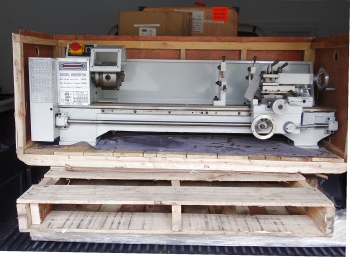 The replacement lathe arrived at the same terminal without incident or accident, along with a milling machine we had also ordered from LatheMaster. I think the whole process took four days. The freight company loaded the crated machines carefully into the back of our pickup and tied everything down so nothing would shift around during the twenty mile ride home over narrow mountain road. Once at the shop, both machines were uncrated so machines and related tools and accessories could be inventoried. Everything was there and intact. Now that was a new experience!
The replacement lathe arrived at the same terminal without incident or accident, along with a milling machine we had also ordered from LatheMaster. I think the whole process took four days. The freight company loaded the crated machines carefully into the back of our pickup and tied everything down so nothing would shift around during the twenty mile ride home over narrow mountain road. Once at the shop, both machines were uncrated so machines and related tools and accessories could be inventoried. Everything was there and intact. Now that was a new experience!
We spent a day or two thinking about how we would need to rig to move the machines from the truck to the inside of the shop, and then how to get the machinery up on their respective work benches. They aren’t extremely heavy, but they are also not in the mini equipment 100 – 150 lbs class either. I think, more than the issue of weight, I was concerned we might stress the machines in a way the machines weren’t intended to be stressed and the result would be a an inability to make anything other than egg shaped and tapered parts. We were in a similar situation when we bought a large gun safe that was on sale at a local retailer and came to the realization we didn’t have the wherewithal to get it to the then newly constructed shop that was thirty muddy and snow covered feet from the driveway.
On the recommendation of our security company, we hired Josh Buker of Portland Safe, 207-893-1800. They are actually in Windham, ME. They picked up the safe from the retailer, transported and transferred the safe to the and installed it cleanly where intended. The lathe and milling machine were handled carefully, supported at the pedestals and everything ended up in the right place without damage or marring. Their prices are more than reasonable and, no, I do not get a price break for making reference to their service. In a place like this, good contractors are hard to come by, so when you find them, you tend to let others know. Besides the cost effective moving skills, they are also a family of firearm enthusiasts and they are polite and professional and comfortable to have around family and friends.
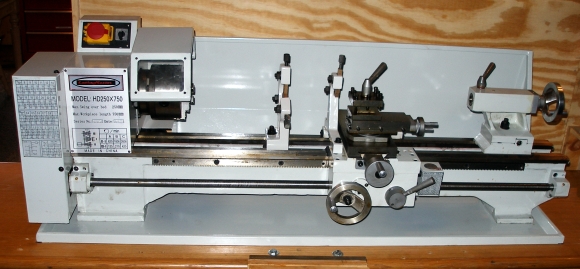
The lathe comes with both bottom and back splash pans. It is bench top mounted through three bolt holes in the pedestals. At 330 lbs, it doesn’t have the steadying mass of a one ton old South Bend, but then it isn’t a 90 lb 7″ lathe either. It doesn’t feel like a toy, it feels like a very solid piece of bench top machinery. I parked mine on an old credenza I’ve owned and dragged around for twenty years. The height is right, the depth and width of the top is perfect and it has a 1 1/2″ oak top with a lot of bottom side support.
Lathe detailed specs:
Swing over Bed: 9 ”
Swing over Cross Slide: 5 7/8″
Distance between centers: 30″
Carriage Travel: 25″
Spindle speeds: 6
(125, 210, 450, 620, 1000, 2000 rpm)
Longitudinal Feeds: 2 (.005,.010)
Inch Threads: 12 (8 – 40TPI)
Metric Threads: 12 (.4 – 3mm)
Cross Slide Travel: 4 1/2″
Compound Travel: 2 5/16″”
Tailstock Spindle Travel: 2 3/4″
Tailstock Taper MT2
Spindle Bore: 20mm (3/4″)
Spindle Taper: MT3
Motor: 3/4 HP, 110V/60Hz
Machine Size: 56″x19″x18 1/2″
Machine weight: 330lbs.
Some of the machines features:
The LatheMaster is not a rebuild on receipt machine. It comes in a condition about the same as good bench power tools purchased from Sears. All it needs is a wipe down and the drive belts installed and it’s ready to go.
The dual prismatic ways are induction hardened and precision ground, supported on a rigid frame.
The spindle is supported on quality tapered bearings.
Feed ratio and thread selection are set with included metal gears.
The lathe cuts left hand threads and make cuts away from the chuck with the easy installation of a feed reverse gear (Included)
The motor is forward and reverse switching.
The lead screws are true inch pitch
Hand wheels and dials are all metal. Scales are satin finished, and clearly engraved in Imperial measure.
And now, nominated for best supporting accessory…the envelope please.
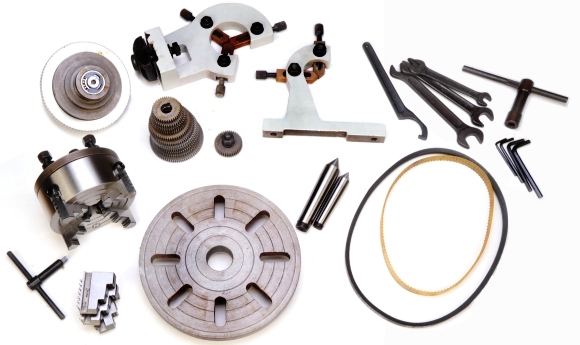
Fortunately, the LatheMaster came with everything above, and a three jaw check, with the exception of the speed reduction pulley pictured just above the four jaw chuck. Fundamentally, it cuts the lathe’s three slowest speeds in half to help facilitate threading, parting and grooving operations. The speed reduction planetary gear assembly is a $129 option. The remaining items are:
Standard accessories included:
5″ – 3 Jaw chuck
5″ – 4 Jaw chuck
Faceplate
4 Way tool post
MT2 & MT3 dead centers
Wrench set
Threading dial
Inch and Metric metal change gears
Steady rest & follow rest
Reverse feed gear
To this I added an inexpensive assortment of cutting tools and a cut off holder and tool. I already had a boring bar set and some other similar types of specialty tools from the old lathe and I saw no reason to buy fancy stuff, because I will probably break everyone of them in my attempt to re-familiarize myself with the machine’s basic operations.
For reference – Defining budgets for additional tools and accessories for a bench top lathe is a pretty exact science. The formula is:

Where the cost of the machine is its purchase price, plus freight and tax. 3 is the 300% more required to buy all the gadgets listed with the machine as optional. 0.1 is the factor that expresses 90% of the tools and accessories will be totally inappropriate for any project you will ever encounter so only 10% of the things you buy will accumulate toward the 300% expense you had planned. As an example, a $1,000 lathe with require an additional $30,000 worth of tool and accessory expenditures before you will arrive at $3,000 worth of tools and accessories that will be of use. The remaining $27,000 worth of…standby tools are used to impress your friends with all of the weird, odd and bizarre projects you could accomplish, if you really had the desire to undertake them.
Some things turns stuff round, others things make them flat…
 We went with LatheMaster for our milling machine for essentially the same company service related issues, expressed customer satisfaction with the product and because it looked like a pretty nifty piece of equipment.
We went with LatheMaster for our milling machine for essentially the same company service related issues, expressed customer satisfaction with the product and because it looked like a pretty nifty piece of equipment.
We had a choice of Lathe Master Models ZAY7045FG or LMT25L, but after restrained consideration, we elected to go with the LMT25L because it had some nice features, it was a few hundred dollars less expensive and, most importantly, it best suited our application. The LMT25L is a major step up from our old micro mill in capacity, useful ease of operation features and heft; 250 lbs for the LatheMaster unit, 90 lbs for the old micro mill. For a couple hundred dollars more than the original it represented an excellent value. Like the lathe, a quick wipe down and it was ready to go. It has some convenient features like variable speed control and digital readout for spindle speed and micro down feed quill. I like the metal hand wheels and the very large table capacity. The R8 spindle size is a plus for tooling.
Milling machine specification:
Variable Speed: 50 to 2250 rpm
Drill Capacity: 1″
Face Mill Capacity: 2 1/2″
End Mill Capacity: 3/4″
Max. Dist. Spindle to Table: 13″
Spindle Type: R8
Spindle Diameter: 1 23/32″
Column Dovetail
Worktable Size: 27 1/2″ x 7″
Table T-Slots: 12mm
Cross Slide Travel (Y-Axis): 6 5/8″
Longitudinal Travel (X-Axis): 19 1/2″
Motor: 1HP DC
Power: 110V/60Hz
Machine Height: 36 1/2″
Machine Width: 38″
Machine Depth: 22″
Base Footprint: 11 1/4″ WIDE x 13 1/2″ DEEP
Weight: 250lbs.
Features:
Large Worktable
Digital readout for spindle speed/micro down feed quill
Head swivels 90 degrees
Horizontal milling / drilling
Extra quiet motor and gear train
Forward / reverse switch
Powerful industrial motor
Standard R8 spindle
Fine calibrated manual down feed
Dials and lead screws in inch measure
Drill Chuck, Arbor, Drawbar, and tool set Included
Quality 30″ tall stand available.
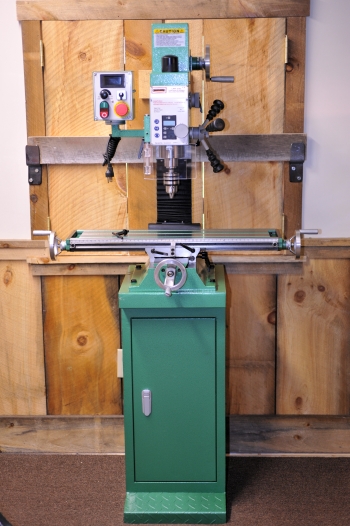 Like the lathe, accessory and tool purchases apply and I found more tool requirements for the milling machine than the lathe. More than cutters there are tool holders, boring heads and more vise types than imaginable. I’ll make sure they are detailed in use as they support firearm related projects. LatheMaster had a nifty pedestal stand with storage for the machine, so that is how we installed the equipment.
Like the lathe, accessory and tool purchases apply and I found more tool requirements for the milling machine than the lathe. More than cutters there are tool holders, boring heads and more vise types than imaginable. I’ll make sure they are detailed in use as they support firearm related projects. LatheMaster had a nifty pedestal stand with storage for the machine, so that is how we installed the equipment.
The lathe runs about $1,195, the milling machine $1,200. LatheMaster also offers an 8″x14″ lathe with the same accessories and in the same finished condition for $869. Higher in cost than the little bench tops, but too many enhancements and real machine shop features not to acknowledge their greater value.
An added benefit. In making room for the machines I reorganized and cleaned the shop. Got my library back in shape and set up open areas for projects. I don’t know if I will get any more work done than I did before, but I can now fake it a lot more by just gesturing to the new machine additions. I am looking forward to writing about breaking parts, tools and machines on the way to proficiency.

Email Notification